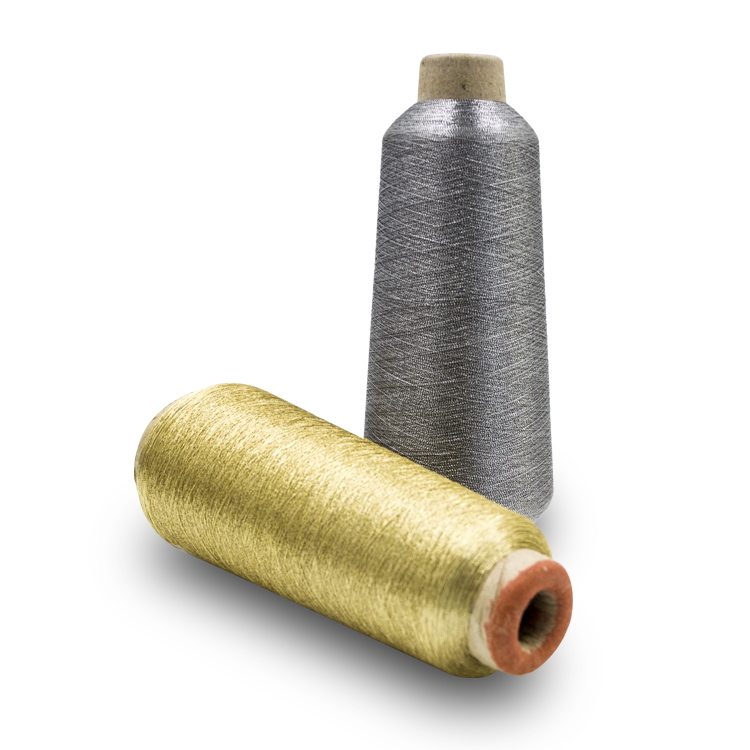
What is gold and silver yarn ?
Gold and silver yarn is a filament twisted from gold and silver silk polyester or rayon. Mainly used in computer embroidery and process accessories.
Gold and silver yarn is widely used in handicraft, fashion, embroidery, gift packaging and other industries, as well as in knitting wool, yarn, knitted fabric, warp knitted fabric, woven fabric, garment accessories, decorative cloth, sofa and other products.
It is an ideal lining material. The fabrics and clothes processed and woven show a sense of elegance, elegance and gorgeousness.
However, because the gold and silver wires are processed by physical method after vacuum aluminizing or vacuum silver plating on polyester film. Therefore, the chemical properties of gold and silver yarn are not stable and can not be used as ordinary textile fibers.
Aluminum film in gold and silver wires is alkali-resistant; silver film is acid-resistant; silver film will blacken when it contacts sulfide; stretching or heavy friction will lead to stripping of metal coating.
Gold and silver staple fibers yarn, processed with imported raw materials, with specifications of 0.05 mm wide, 25 mm, 38 mm, 60 mm, 90 mm or designated by customers, in various colors such as gold, silver, black, pearlescent, bright red, sapphire blue, etc., are suitable for natural fibers and synthetic fibers (cotton, wool, silk, cashmere, cotton velvet, acrylic fibers). nylon, viscose, tencel, modal, corn fiber, pearl fiber, chitin fiber, etc.) blended with various components of knitting, shuttle yarn semi-worsted wool yarn, cashmere yarn and other products, used in all kinds of knitted and knitted fabrics or non-woven fabrics, the blending ratio is generally 1%-2%, which can add jewelry and rainbow to fabrics.
The special visual effect of metallic luster is due to the fact that the fineness of gold and silver staple fibers is comparable to that of cashmere fibers, which does not affect the handle of fabrics, and can obviously improve the grade of products and increase the added value of products.
uch as electronic parallel machine, automatic winder of Saivo Company of Italy, double twister of Sula (Switzerland) Faulkman Company, and advanced testing instruments such as fiber tester, electronic strength tester and Uster evenness tester made in Switzerland. Gold and silver staple fibers (specifications: 4D-6D*38mm) are used. )
With cotton, viscose, acrylic, polyester, wool and other natural and chemical fibers to produce color spinning, product varieties: 20Nm - 100Nm.

The company mainly produces gold and silver flash optical fiber yarn dimension or called gold and silver strip, with complete color specifications.
It is used to produce gold and silver staple colour yarn and gold and silver staple fiber embryo yarn, the number of fibers is 4d-20d; the length is 25mm-200mm.
It can be used in air spinning, eddy spinning, ring spinning, semi-worsted, compact spinning, wool spinning and other different staple yarn factories to produce gold and silver staple yarn.
After years of research and development, gold and silver yarn staple fibers for papermaking/non-woven/carpet yarn/leather are produced.
All products have passed the international textile environmental protection certification, the color fastness level reaches 8 grades, the heat resistance reaches 200 degrees, and the high quality golden and silver flicker fiber dimension does not fade.
Silver yarn
Flower thread technology is a fine gold technology that processes gold and silver into yarn silk, and then makes gold and silver jewelry by means of winding, pinching, filling and stacking.
According to the different decorative parts, different patterns of flower yarn silk, arch yarn silk, slub yarn silk and wheat ear yarn silk can be made.
The production methods can be divided into pinching, filling, saving, welding, stacking, base, weaving, knitting and so on.
1. Shredding is a groove made of filament, which is made into plum, peony, birds, dragons and phoenixes, pavilions and other patterns.
2. Filling is to pinch flat filaments into the design outline. The commonly used species are filling arch silk, filling petals, etc.
3. Cumulative welding is the process of assembling the patterns and forming complete jewelry by welding.
4. Stacking is the process of sieving and welding powder with small sieve by winding the code wire evenly on the carbon ash shape by the method of stacking carbon ash.
5. Knitting is to knit the edge pattern of gold and silver yarn silk and the bottom pattern of different shapes, then stick on the bottom pattern and make different patterns by various process methods, and finish by welding.

Category:
(1) M type silver yarn:
The product is made of polyester film yarn cut directly by a slitting machine with very high precision. The colour is gorgeous and dazzling. Colors are generally divided into silver, light gold, deep gold, tricolor, Pearl hallucination, laser and other colors.
Mainly used for lace, ribbon, trademark, embroidery, hosiery, scarf, warp knitting, sofa, hairdressing, kitchen washing products, etc.
(2) MH type silver yarn
The product is made of single slice of gold and silver filament twisted with polyester, nylon, rayon, rayon or other kinds of yarns.
The product has soft texture and gorgeous color.
The product is widely used in plain weaving, knitting, woolen sweater, scarf, hosiery, Christmas supplies and so on.
(3) L/J type silver yarn
Also known as embroidery yarn, L is made of single slices of gold and silver filament twisted with polyester, nylon, rayon, cotton yarn and other yarns at a fixed very small interval.
J is made of single slice of gold and silver filament twisted with polyester, nylon, rayon and cotton yarns at a fixed distance.
The product is columnar in shape and has good strength. It is widely used in computer embroidery, hand embroidery, fishing gear, trademark, ribbon, sweater, warp knitting, etc.
(4) MX type sliver yarn
The product is made of single slice of gold and silver filament and two-way embracing with polyester, nylon, rayon, rayon or other kinds of yarns.
Widely used in trademark, warp knitting, ribbon, yarn-dyed, jacquard, etc.





